The Joy of Visiting and Learning About Local Artisanship
Travel to experience the culture of Yamagata and Tokyo
Yamagata is a treasure trove of delicious foods and excellent sake created from an abundance of nature’s blessings. Tokyo has prospered as one of the world’s largest cities and is a place where the latest advances and traditions exist side by side. The prefecture and metropolis have begun a partnership that promotes each other’s tourist attractions. Here, we introduce recommendations for getting to know the places through artisanship, excellent sake, and onsen and accommodations.
FUJINGAHO published in March 2024
Photo:Akinori Maekawa Text:Mari Matsubara
Take a trip to discover the attractions of each location
Did you know the only two places in Japan with a female governor are Yamagata Prefecture and Tokyo? These two have partnered to encourage tourism in both locations, and endeavors are underway in accordance with a proposal from Governor Mieko Yoshimura of Yamagata Prefecture and Governor Yuriko Koike of Tokyo. Yamagata Prefecture has terrain surrounded by mountains such as Mt. Zao, Mt. Gassan, and Mt. Chokai, and scenic landscapes favored with underground water fed by the Mogami River, known as the “mother river.” Not only is it a rice-producing region, but it also has thriving agriculture that grows a variety of flowering plants and fruits, including the local specialty, cherries. As the saying goes, “where there is good water, there is good sake,” and in Yamagata there are over 50 sake breweries. Meanwhile, Tokyo is a city that shares world-class culture. It goes without saying that the city’s attraction lies in being a metropolis where every kind of information is available, but it is also a city where traditional artisanship lives on. Plus, there is more to Tokyo than its 23 wards. The Tama area on the city’s western side still retains rich nature such as the woodland of Musashino and Mt. Takao. Sake brewing has also flourished there since long ago due to benefits provided by the Tama River system. Although Yamagata Prefecture and Tokyo are separated by a distance of more than 300 kilometers, we’ll share what both locations have in common, artisanship, sake, and onsen and accommodations.
First, we traveled to Yamagata. Wanting to learn about artisanship, we visited Oriental Carpet Mills, Ltd. in the town of Yamanobe where high-end carpets called Yamagata Dantsu are made. The carpets are woven using two techniques. One is handweaving where wool yarn is tied by hand to the warp, and the other is hand embroidery where wool yarn is woven using a tool called a hook gun. It’s said the carpets last many years because the density of the wool is so high that it’s difficult for the pile to wear out. The handwoven products require patience, given that only a few centimeters can be woven in a day. Said to last a hundred years, the carpets are used in famous hotels, art museums, and public facilities. There is currently a hand-embroidered carpet in the main lobby of Kabukiza.
Kojima Sohonten, known for the excellent sake brand, Toko is a long-established brewery in Yonezawa that has existed since the Azuchi–Momoyama period. The snowmelt in this region of heavy snowfall totals seven meters a year and contributes to the production of superb sake. The Brewing Museum Toko no Sakagura, just a few-minutes walk from the head office, is housed in a renovated earthen-walled storehouse that is over a century old. You can see tools such as vats used for sake brewing long ago and what day-to-day life was like in the Meiji period, as well as enjoy taste-testing sake.
The fact that many onsen are found throughout the prefecture is one of the biggest draws to Yamagata. Each guest room in Kaminoyama Hayama Onsen Meigetsuso features completely different interior decor. After ongoing updates to hospitality services while renovating one guest room a year, this onsen inn has succeeded in attracting repeat guests who visit every month, and families wanting a large guest room to use like a vacation home that accommodates three generations of family. The site is full of different ways for you to relax throughout your stay, including facilities such as a gallery, a wine cellar, a beauty spa, a sauna, and a library.
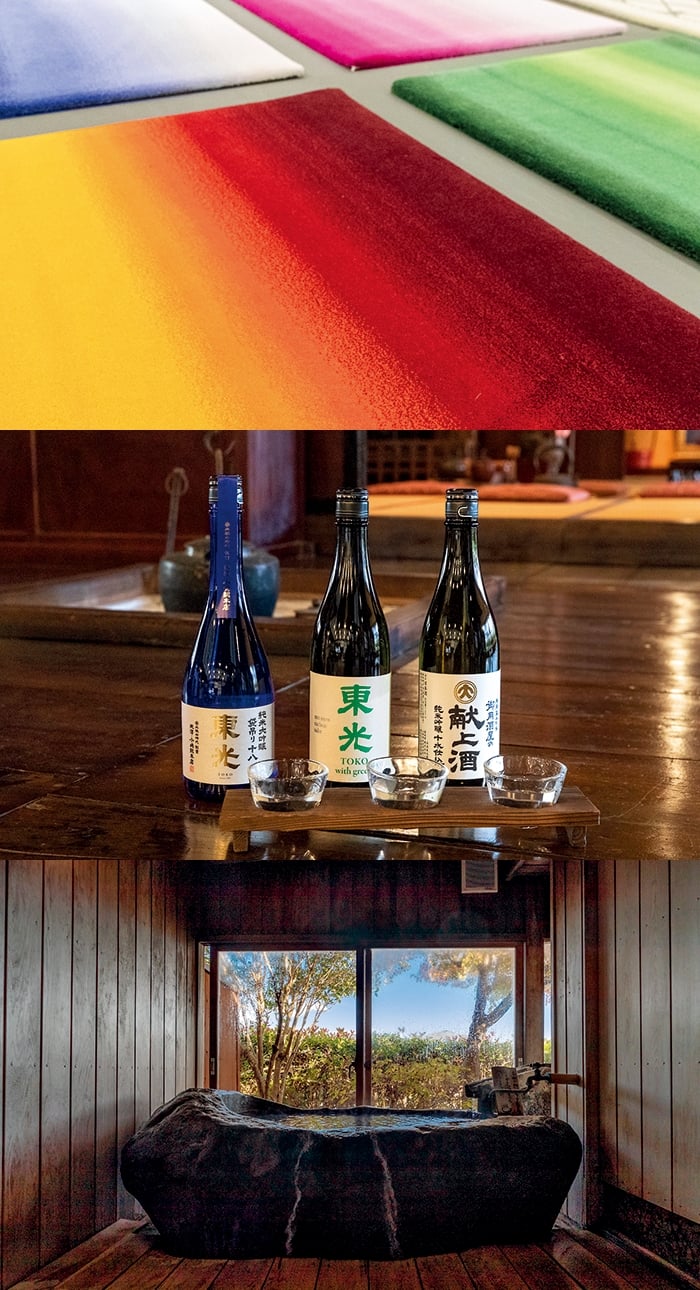
Next, we journeyed straight from Yamagata to Tokyo. We visited Tomita Dyeing & Crafts in Nishiwaseda. Since long ago, there have been dyeing businesses along the Kanda River that produced the Edo Komon and Edo Sarasa dye patterns. This workshop has preserved 120,000 Ise Katagami stencils. Even today, the artisans carry out the entire process by hand, including applying paste for dyeing, steaming, and washing. The company also offers tours of Tokyo Craft Dyeing Story Museum and hands-on dyeing experiences.
Ishikawa Brewery is one of ten breweries that are members of Tokyo Sake Brewer’s Association. It’s located near JR Haijima Station, approximately an hour by car from central Tokyo. Within the spacious site, water flows from the Tama River water supply system, there are Japanese zelkova trees around 700 years old, and white plaster-walled storehouses scattered about. Today, sake brands including Tamajiman are still prepared and stored in the main brewery, which was completed in 1880 and has been designated a national registered tangible cultural property. There are many ways to enjoy the site in addition to tours of the storehouses, including eating a meal at the restaurant on the grounds and buying unprocessed sake that can only be purchased here.
After returning to the city center, we stayed overnight at Hotel New Otani. Needless to say, this hotel is representative of Japan. To commemorate its 60th anniversary in 2024, for the first time it has introduced cypress wood baths to its suite and deluxe rooms in Executive House Zen, which takes up the 11th and 12th floors. These rooms let you experience the ultimate retreat in the city center. The aroma of cypress faintly emanates throughout the universally designed bathrooms that have a modern Japanese interior with traditional Japanese designs.
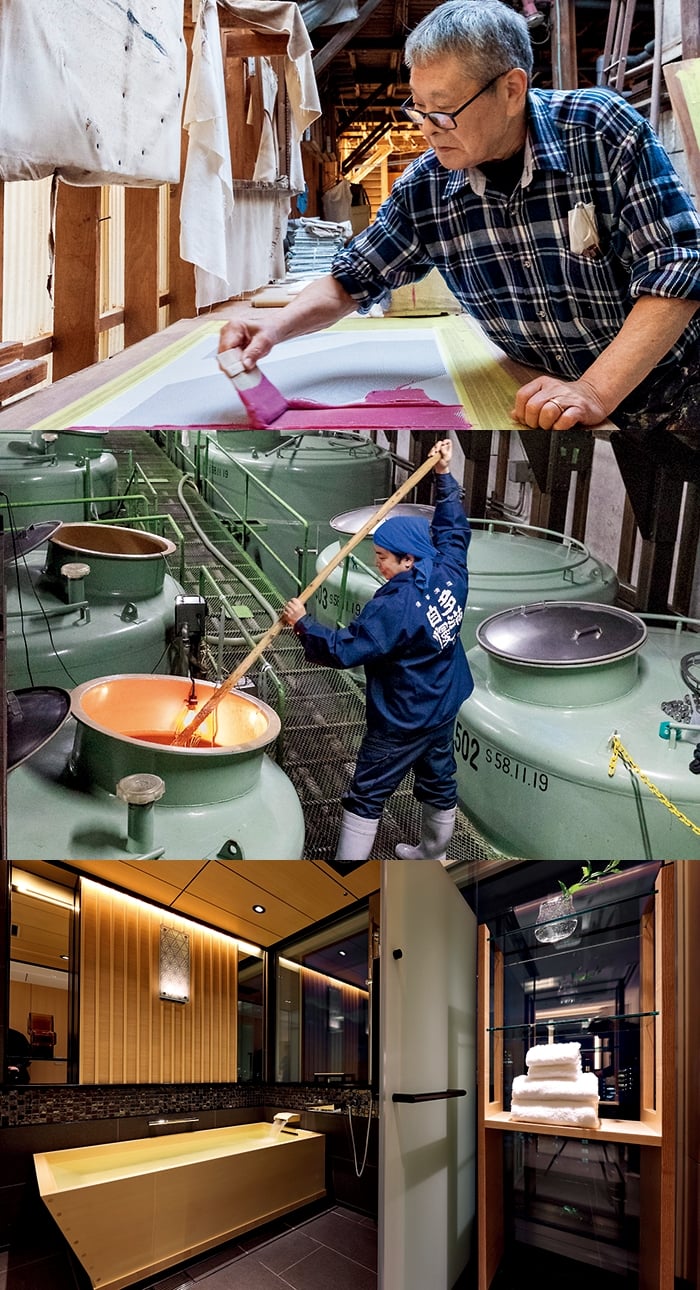
Recommended spots
Oriental Carpet Mills
head office workshop/hands-on experience area
Yamagata Dantsu are of the highest quality and durability, and last for many years
Junnosuke Watanabe, who ran a cotton textile business, invited carpet craftsmen from Beijing to serve as instructors, and established the company in 1935 with the aim of creating steady employment for young women in the community who were suffering due to a poor harvest and economic slump. This is the only carpet workshop in Japan that carries out integrated management inhouse, from creating threads to dyeing, weaving, and finishing. The premium quality made possible by intricate artisanship has been recognized by master architects such as Junzo Yoshimura and Yoshiro Taniguchi. The carpets have been used in numerous buildings that retain Japan’s history of modern architecture. The company’s Yamagata showroom, which has an area for hands-on experiences, was designed by the architect, Yoshifumi Nakamura and completed the year before last. When you touch the carpets you can clearly feel the exceptional texture of the amazing,highly dense pile,and can fully understand that they are of a quality that can be passed down to children and grandchildren without the color fading and with the resilience intact. The company also offers workshop tours by reservation for the public every Thursday and Friday, and every other Saturday.
-
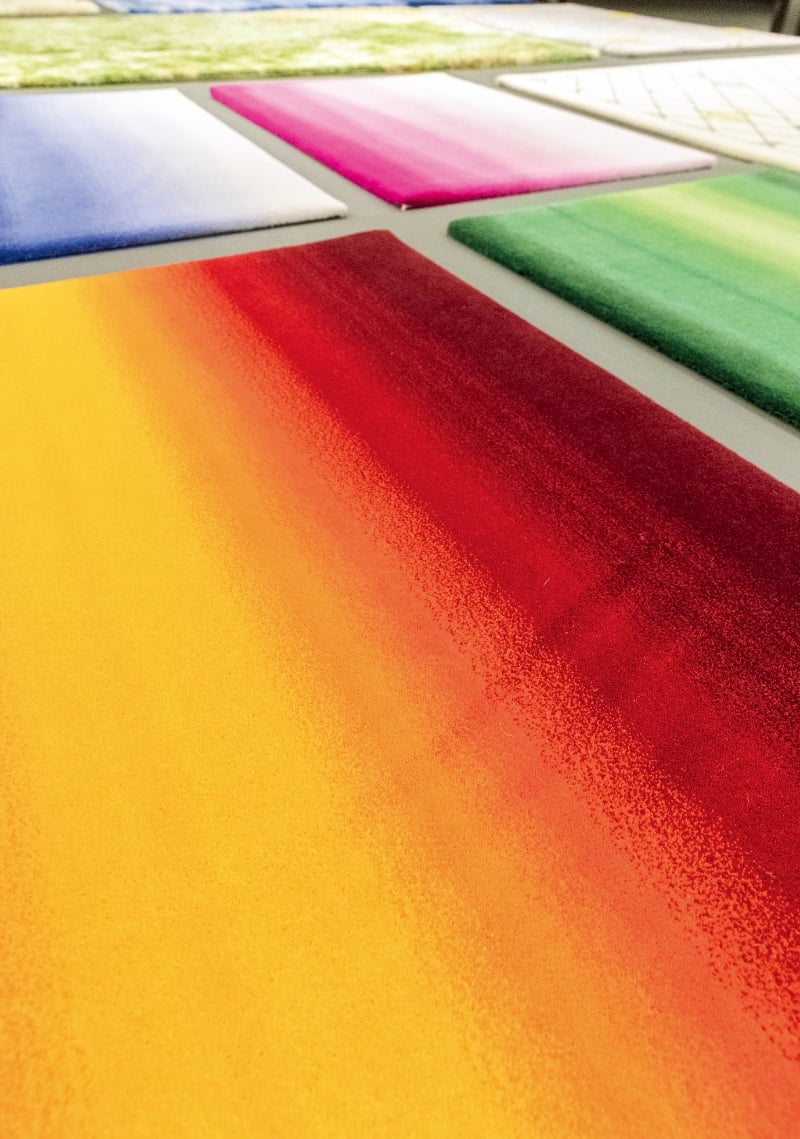 The Yamagata showroom/hands-on experience area was completed in 2022. Experience for yourself the beauty of the yarn dyeing, the soft texture, and the resilience that pushes back against your hand when you touch it.
The Yamagata showroom/hands-on experience area was completed in 2022. Experience for yourself the beauty of the yarn dyeing, the soft texture, and the resilience that pushes back against your hand when you touch it. -
-
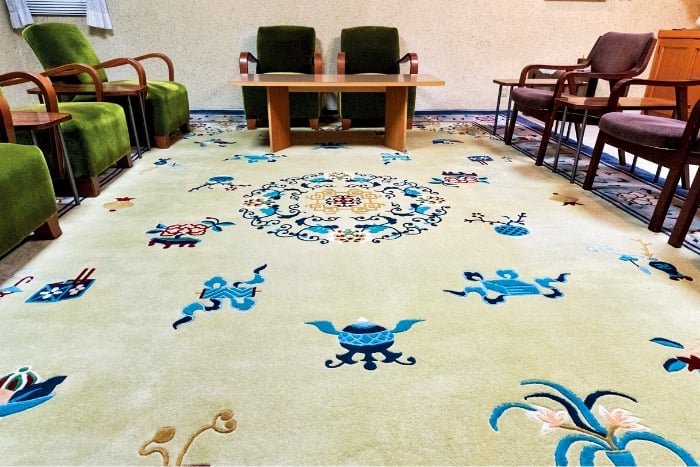 The carpet in the visitor’s room was hand woven around 80 years ago. The carpet’s resilience has not been lost and the color remains bright. You would never believe it has been in use and continuously exposed to the sun for so many years. That proves the quality can be maintained for a long time through regular washing.
The carpet in the visitor’s room was hand woven around 80 years ago. The carpet’s resilience has not been lost and the color remains bright. You would never believe it has been in use and continuously exposed to the sun for so many years. That proves the quality can be maintained for a long time through regular washing. -
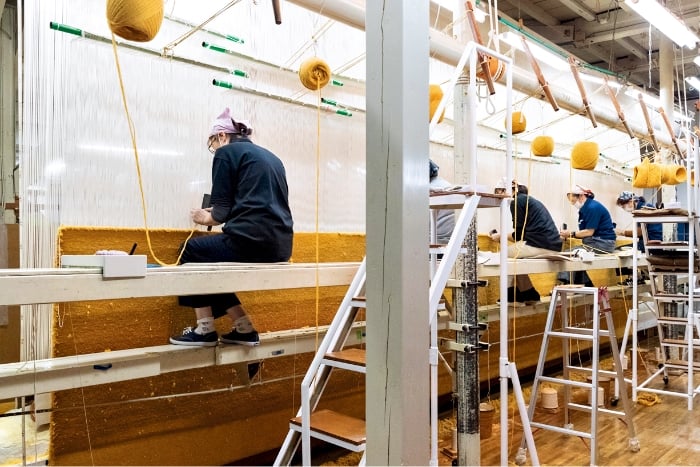 Several artisans line up to work on extra-large carpets measuring over eight meters in width. While not patterned, the fine gradations in color tone result from weaving techniques and a stock of wool yarn in over 20,000 colors.
Several artisans line up to work on extra-large carpets measuring over eight meters in width. While not patterned, the fine gradations in color tone result from weaving techniques and a stock of wool yarn in over 20,000 colors. -
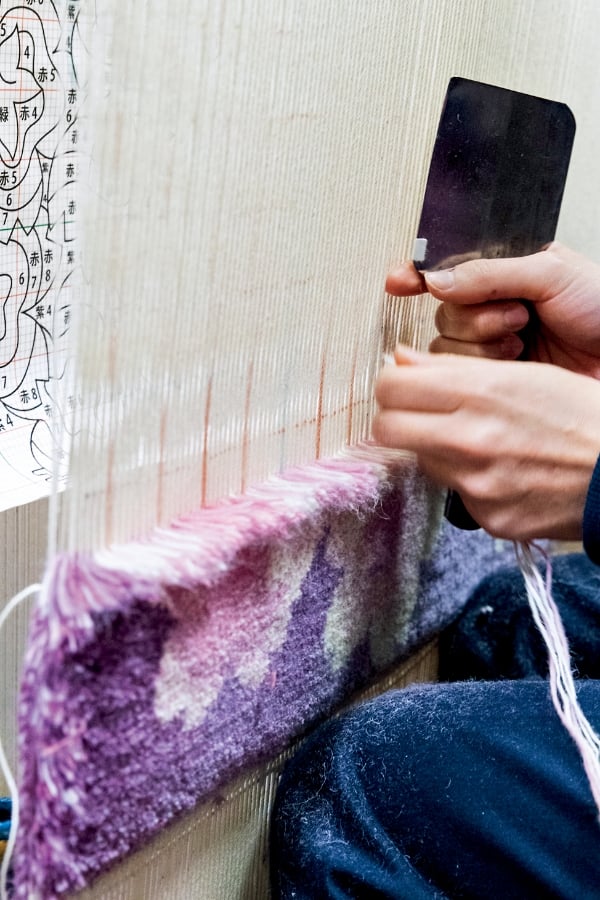 On the underside of the warp is a production pattern on graph paper, and wool yarn is tied and cut according to the designated colors.
On the underside of the warp is a production pattern on graph paper, and wool yarn is tied and cut according to the designated colors.
-
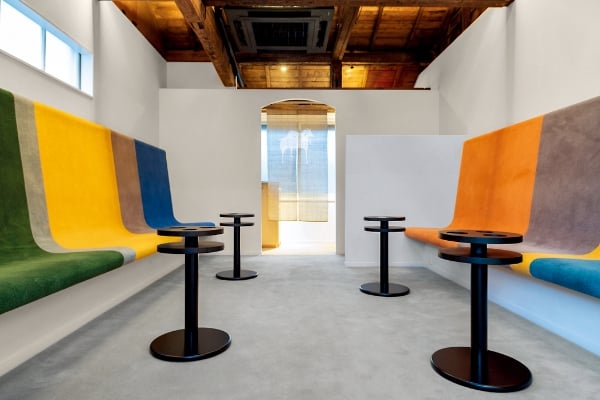
- Address
- 21 Yamanobe, Yamanobe-machi, Higashimurayama-gun, Yamagata Prefecture
- Telephone no.
- 023-664-5811
- Business hours
- 9:00-17:00
- Regular closures
- Saturdays, Sundays, public holidays
Brewing Museum
Toko Sake Museum
Experience a sake-brewing site in the Meiji period
Founded in 1597, Kojima Sohonten at one time was the official sake brewery for the Uesugi family of the Yonezawa Domain. The current company president is the family’s 24th generation. On the grounds where the head office stands, there are many white plaster-walled storehouses, and the factory producing the sake brand, Toko and related facilities are dotted about. The secret to great-tasting sake lies in the abundance of snowmelt that flows from Mt. Azuma and the process of making high-quality rice that starts with preparing the rice paddies . The sake brands are produced inside an old sake brewery. In addition, the brewery has recently developed “Kome-koji no Amasake,” a sweet non-alcoholic drink made from fermented rice and mixed with a smoothie of fruits and vegetables. It has also been highly rated overseas for sustainable sake brewing. If you want to learn about the history and process of sake brewing, head to the Brewing Museum Toko Sake Museum. You’re sure to be fascinated by the old buildings that have been restored using traditional construction methods.
-
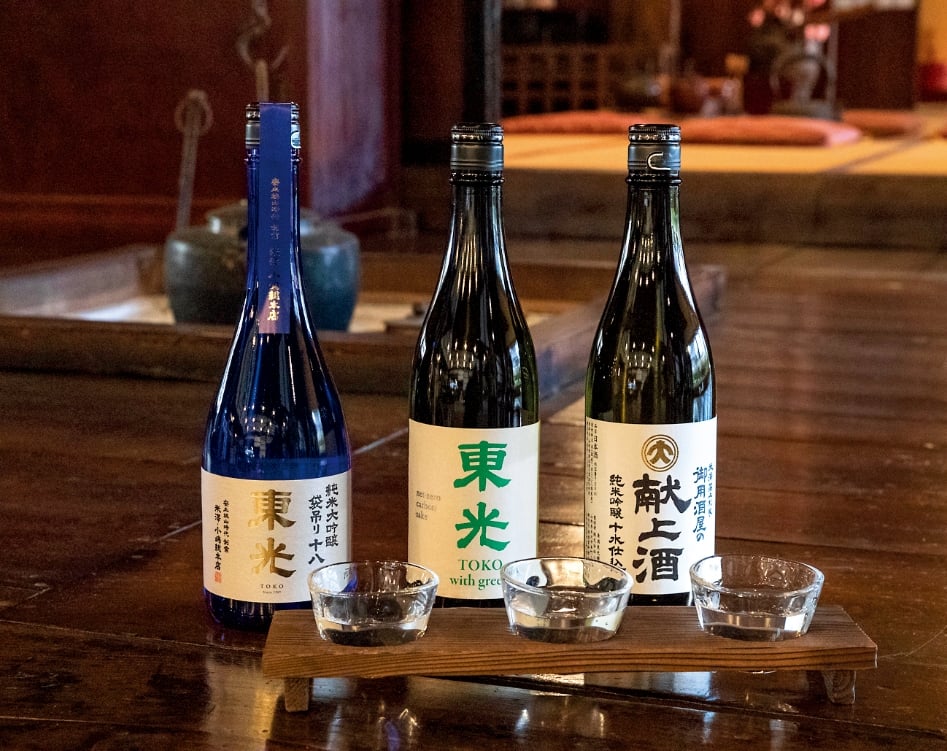 From the left, “Toko Junmai Daiginjo Fukuro-tsuri Juhachi” (11,000 yen; 720 ml) Using rice polished to 18%, this sake is made from drops that fall due to gravity from a suspended filter bag. “Toko with green” (1,540 yen; 720 ml) This junmai sake is made using the gentle, natural energy produced by sake lees. “Yonezawa-han Uesugi-ke Goyosakaya no Kenjoshu” (official sake of the Yonezawa Domain Uesugi family; 2,200 yen) This product is on sale for a limited time only from the Toko brewery.
From the left, “Toko Junmai Daiginjo Fukuro-tsuri Juhachi” (11,000 yen; 720 ml) Using rice polished to 18%, this sake is made from drops that fall due to gravity from a suspended filter bag. “Toko with green” (1,540 yen; 720 ml) This junmai sake is made using the gentle, natural energy produced by sake lees. “Yonezawa-han Uesugi-ke Goyosakaya no Kenjoshu” (official sake of the Yonezawa Domain Uesugi family; 2,200 yen) This product is on sale for a limited time only from the Toko brewery. -
-
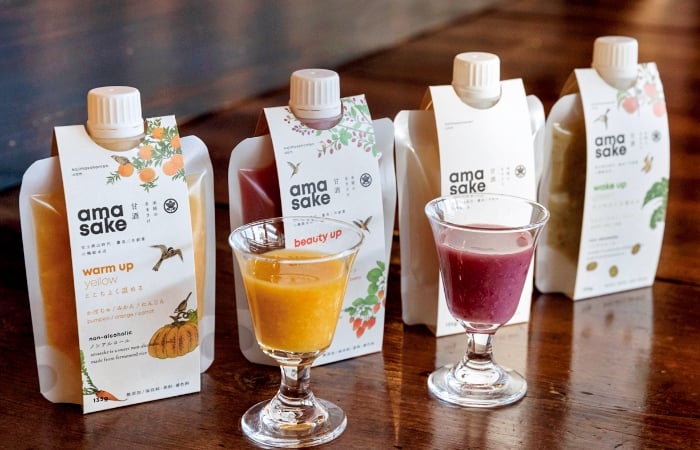 “Kome-koji no Amasake” (432 yen; 135 g) There are four types that contain berries and vegetables such as pumpkin, carrot, and ginger.
“Kome-koji no Amasake” (432 yen; 135 g) There are four types that contain berries and vegetables such as pumpkin, carrot, and ginger. -
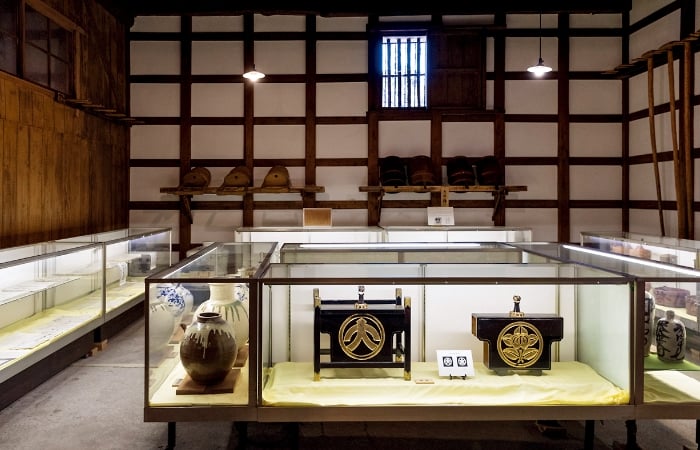 There are exhibits of sake brewery tools and daily necessities.
There are exhibits of sake brewery tools and daily necessities.
-
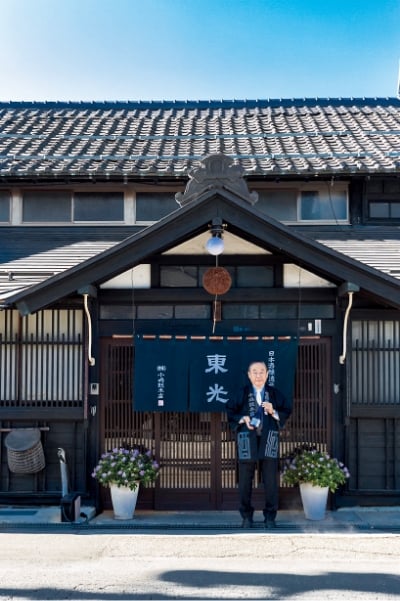 The previous 23rd-generation president, Yazaemon Kojima stands in front of the head office where a ball of Japanese cedar sprigs hangs. The head of the brewery has assumed this name in each generation.
The previous 23rd-generation president, Yazaemon Kojima stands in front of the head office where a ball of Japanese cedar sprigs hangs. The head of the brewery has assumed this name in each generation.
- Address
- 2-3-22 O-machi, Yonezawa-shi, Yamagata Prefecture (on Yanagimachikami-dori St.)
- Telephone no.
- 0238-21-6601
- Business hours
- 9:00-16:30
- Regular closures
- December 31st, January 1st
*General admission for tours is 350 yen. Closed on Tuesdays from January to March. There is a fee-based taste-testing area and direct sales of products from the brewery.
Meigetsuso
Guests can fully appreciate Yamagata’s scrumptious foods and superb sake in the inn’s detached-style guest rooms
Pass under a gate where a “noren” curtain is hung and enter a gazebo with a sunken hearth where you can take a little rest. Advance further along the approach to reach the entrance. Meigetsuso is an exceptional inn overflowing with a nostalgic mood. You’ll find yourself feeling at home, even on your first visit. All guest rooms are in a detached style and have a different appearance. Not only will you be able to relax as you please in your room, but you can also unwind in a corner or one of the facilities scattered throughout the large site. These include a parlor reminiscent of an English farmhouse, a lounge with a terrace, a salon facing the inner court to use after taking a bath, and a gallery housed in a relocated, renovated storehouse from the Taisho period. There is always work being done on the inn to replace the old with the new and maintain the inn’s interior, so you’ll never fail to be amazed whenever you visit, which is why there is a steady stream of repeat guests. Of course, you can enjoy upscale, multi-course meals prepared with foods from Yamagata, and onsen with abundance of hot spring water, including large baths and open-air baths.
-
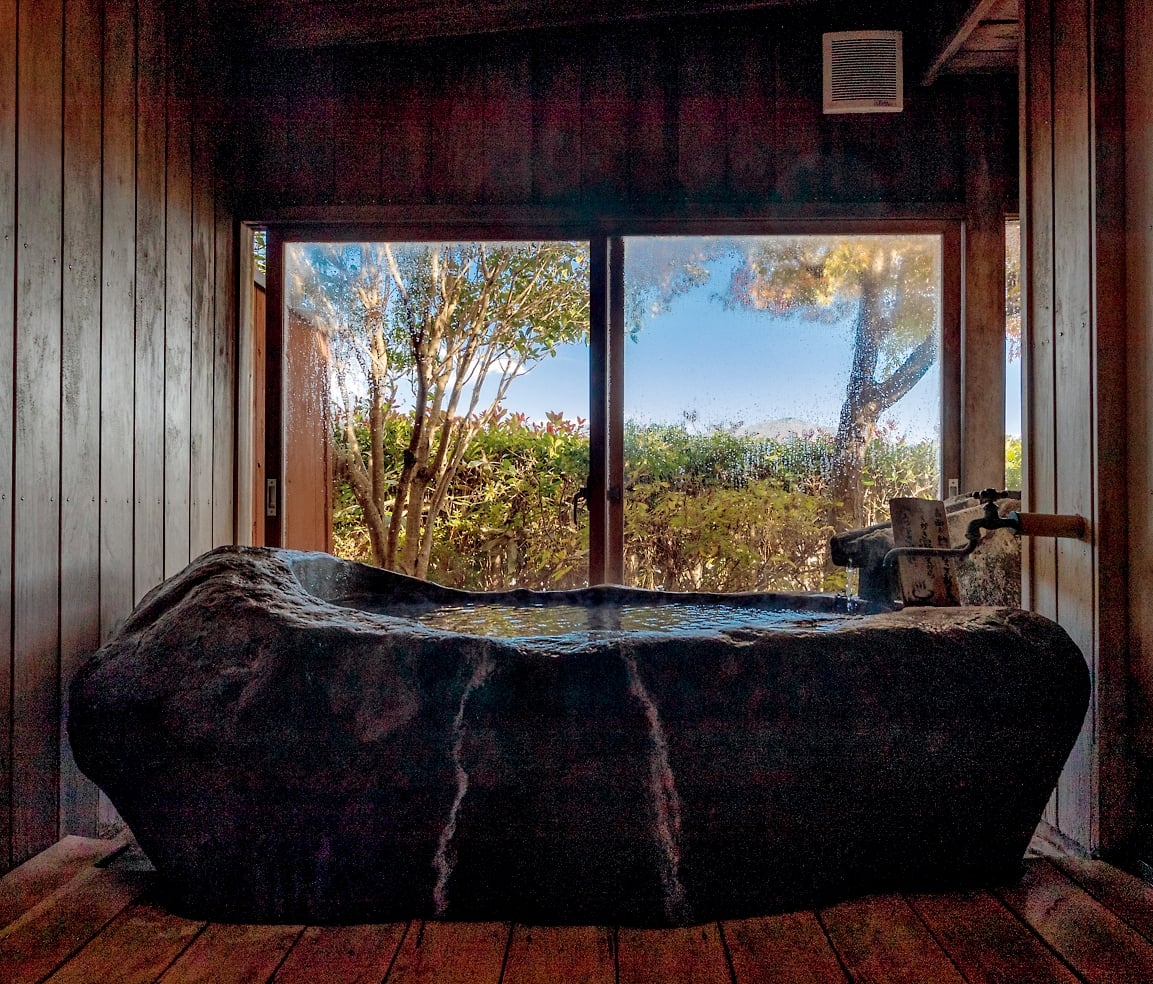 The guest room, Hanada was renovated in 2022 and has a stone bath carved from Zao rock that exudes rustic beauty.
The guest room, Hanada was renovated in 2022 and has a stone bath carved from Zao rock that exudes rustic beauty. -
-
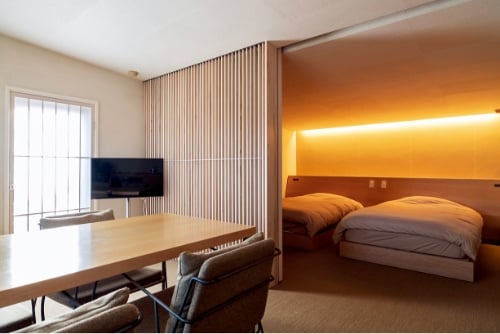 This is the living area and bedroom in Hanada. The walls decorated with white Japanese “washi” paper create a bright atmosphere. The secret to its popularity is the view of the Zao mountain range from the window. It includes a room measuring eight “tatami mats” in a traditional Japanese style.
This is the living area and bedroom in Hanada. The walls decorated with white Japanese “washi” paper create a bright atmosphere. The secret to its popularity is the view of the Zao mountain range from the window. It includes a room measuring eight “tatami mats” in a traditional Japanese style. -
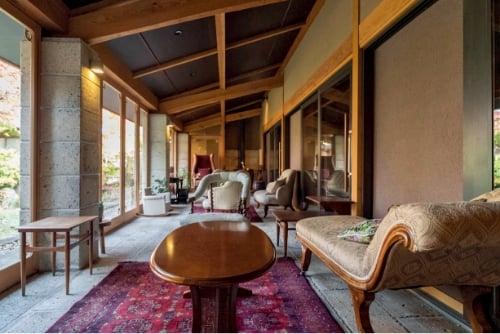 The after-bath salon faces the inner court. The Oya-ishi stone floor is carpeted, so you can relax as if in your own home. In addition to free hot drinks, Yamagata’s specialty, “tama konnyaku” (ball-shaped konjac) is prepared here every day.
The after-bath salon faces the inner court. The Oya-ishi stone floor is carpeted, so you can relax as if in your own home. In addition to free hot drinks, Yamagata’s specialty, “tama konnyaku” (ball-shaped konjac) is prepared here every day.
-
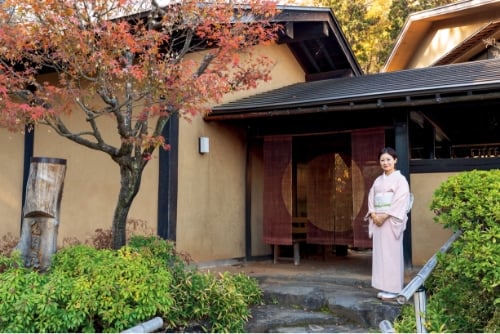 Masako Kikuchi is the inn’s proprietress-to-be. The former radio DJ has a beautiful voice and charming, gentle smile.
Masako Kikuchi is the inn’s proprietress-to-be. The former radio DJ has a beautiful voice and charming, gentle smile.
- Address
- 5-50 Hayama, Kaminoyama-shi, Yamagata Prefecture
- Telephone no.
- 023-672-0330
- Fee
- Rate per person/night for double occupancy with two meals starts at 40,300 yen;
Tokyo Craft Dyeing Story Museum
(Tomita Dyeing & Crafts)
Passing on dyeing techniques for Edo Komon and Edo Sarasa patterns to the next generation
Tomita Dyeing & Crafts, one of the oldest Edo Komon and Edo Sarasa workshops, opened at its current location in 1914. The skilled artisans carry out everything from mixing color paste to stencil printing and steaming, washing, and finishing at the long, narrow workshop on the premises. Since 2012, the company also has been developing dye colors for neckties, scarfs, and even small leather goods, ceramic tiles, and lumber. It has commercialized these products under the SARAKICHI brand. These creations are being manufactured out of the compelling belief that dyeing techniques and stencils must be preserved for the next generation, even in an era of Westernized dress culture. This company still retains the old-fashioned workshop environment with long tables arranged in a row for stencil printing, and as the Tokyo Craft Dyeing Story Museum, it offers tours and hands-on experiences dyeing wrapping cloths and tote bags.
-
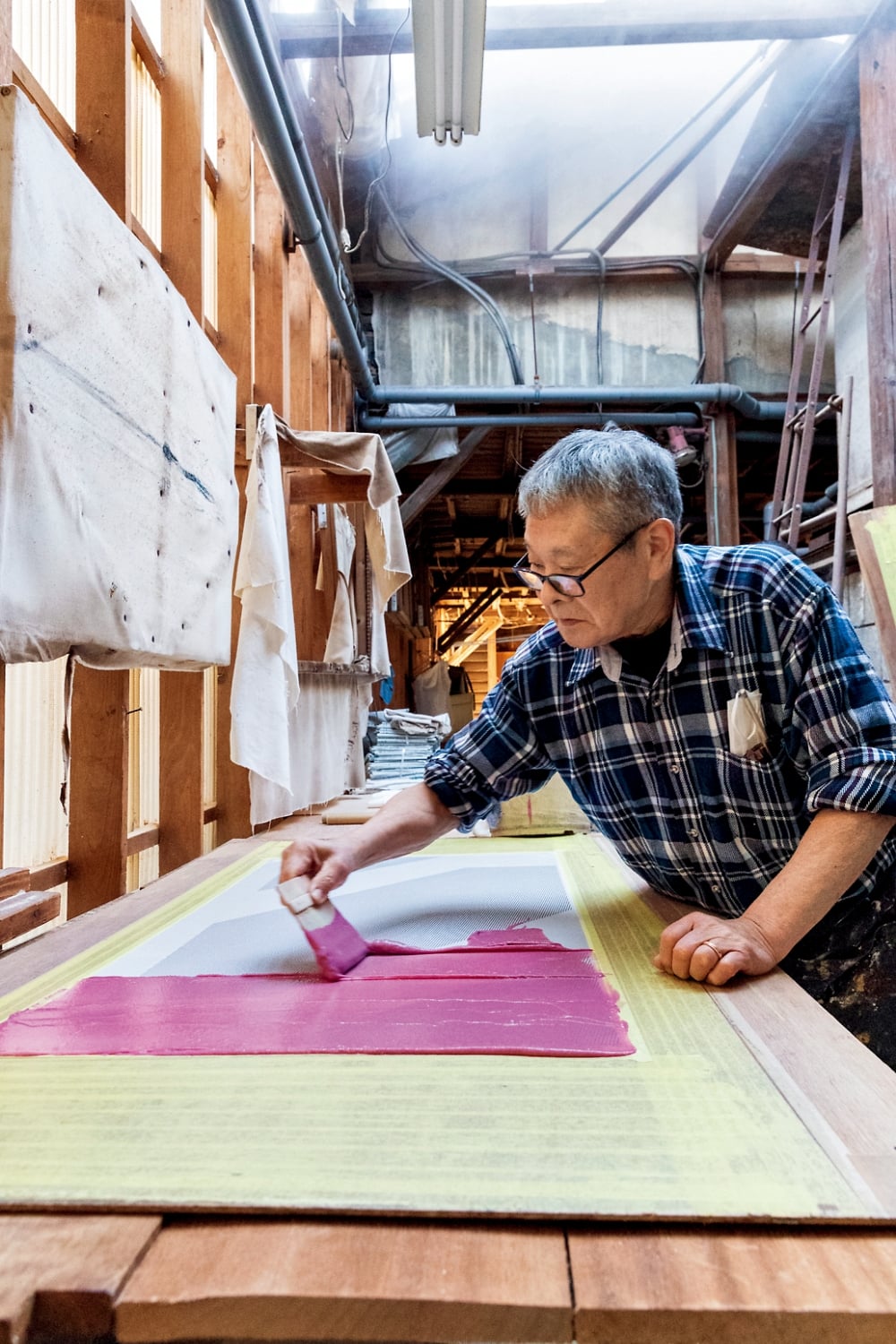 Stencils are stacked on top of silk fabric that will become neckties, and the color paste is applied. In the Yuzen dyeing technique, color is directly placed on the cloth, but using that method for Edo Komon causes the color to seep into the cloth and blur the detailed pattern, so color mixed in paste is used for stencil dyeing.
Stencils are stacked on top of silk fabric that will become neckties, and the color paste is applied. In the Yuzen dyeing technique, color is directly placed on the cloth, but using that method for Edo Komon causes the color to seep into the cloth and blur the detailed pattern, so color mixed in paste is used for stencil dyeing. -
-
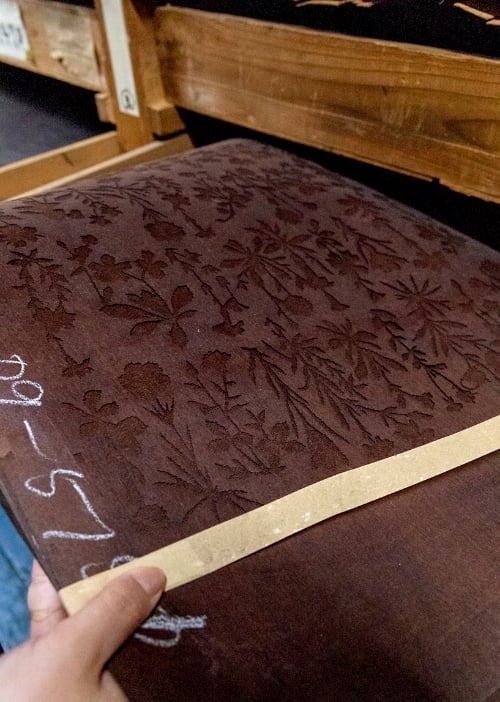 The 120,000 old original Ise Katagami stencils stored in old drawers are truly the lifeblood of the dyeing industry.
The 120,000 old original Ise Katagami stencils stored in old drawers are truly the lifeblood of the dyeing industry. -
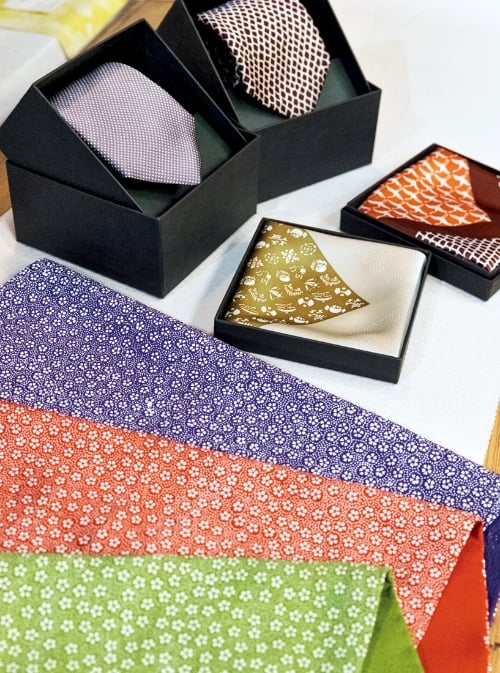 SARAKICHI brand neckties and pocket handkerchiefs are in the back. Neckties with the Arare Komon and Gyogi Komon patterns have a different, tasteful pattern in the lining that can be glimpsed. In front is an example of a wrapping cloth that is dyed during the hands-on experience.
SARAKICHI brand neckties and pocket handkerchiefs are in the back. Neckties with the Arare Komon and Gyogi Komon patterns have a different, tasteful pattern in the lining that can be glimpsed. In front is an example of a wrapping cloth that is dyed during the hands-on experience.
-
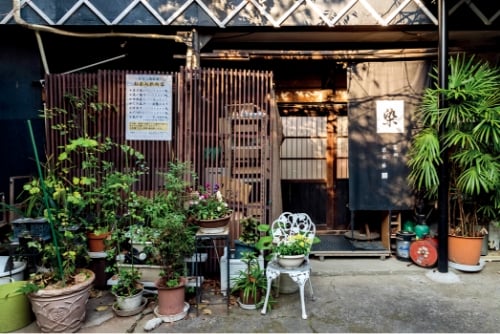
- Address
- 3-6-14 Nishiwaseda, Shinjuku-ku, Tokyo
- Telephone no.
- 03-3987-0701
- Business hours
- 9:00-16:00 (Closed 12:00 to 13:00)
- Regular closures
- Saturdays, Sundays, public holidays
*The workshop tour and hands-on experience together require 1½ to 2 hours. The participation fee is 4,500 yen for a wrapping cloth and 2,500 yen for a small piece of cloth.
Ishikawa Brewery
Excellent sake brands from Tokyo nurtured by the blessings of water from the Tama River
In 1863, the 13th-generation head of the Ishikawa family began brewing sake using high-quality water from the Tama River system. Ishikawa Brewery is now run by the 18th-generation CEO, Yahachiro Ishikawa. The six storehouses have escaped both war and earthquakes, and have been designated national registered tangible cultural properties. While the brewing process switched from wooden barrels to tanks in the late 1960s to early 1970s, the main brewery that was built in the Meiji period has been repaired along the way, but still appears as it did long ago. The storehouses constructed of a wooden framework and plaster walls maintain a room temperature between 10–17°C, which is the ideal environment for sake brewing. In addition to a historical museum, the site is full of items that create an enticing atmosphere, including an old well, a pair of zelkova trees around 400 years old, and a pot with a diameter of 2.7 meters used for a few years from 1887 when beer was also brewed. Several types of tours are available, such as a workshop held inside the main brewery.
-
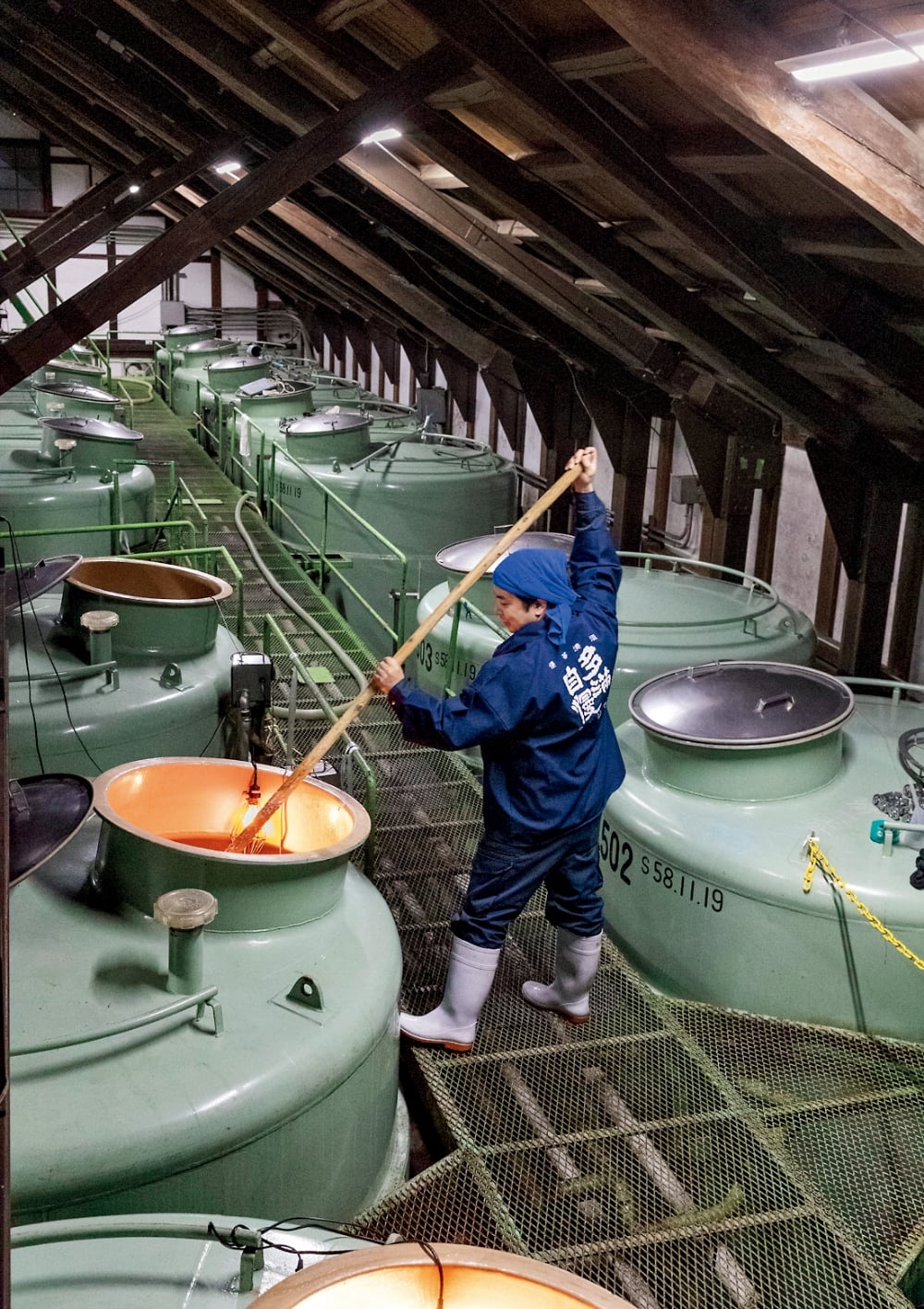 Sake-brewing tanks line the main brewery. Preparation takes place from around September to March the following year, then the brew is mixed with paddles and the state of fermentation is checked. Inside, the yeast creates bubbling foam.
Sake-brewing tanks line the main brewery. Preparation takes place from around September to March the following year, then the brew is mixed with paddles and the state of fermentation is checked. Inside, the yeast creates bubbling foam. -
-
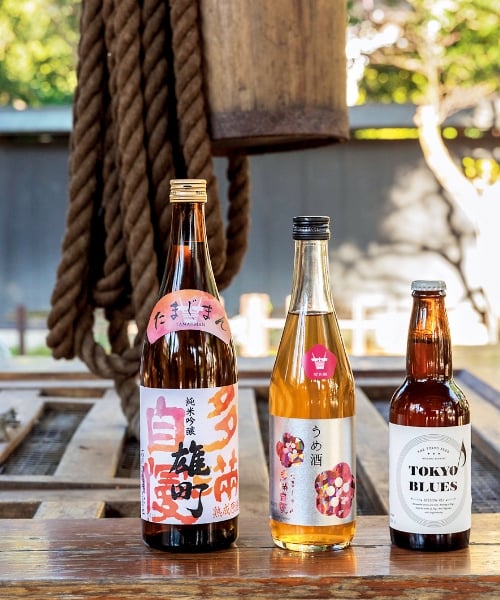 From the left, “Tamajiman Omachi Jukusei Genshu” (matured undiluted sake; 1,980 yen; 720 ml), “Umeshu” (1,320 yen; 500 ml), “Session Ale” (570 yen; 330 ml)
From the left, “Tamajiman Omachi Jukusei Genshu” (matured undiluted sake; 1,980 yen; 720 ml), “Umeshu” (1,320 yen; 500 ml), “Session Ale” (570 yen; 330 ml) -
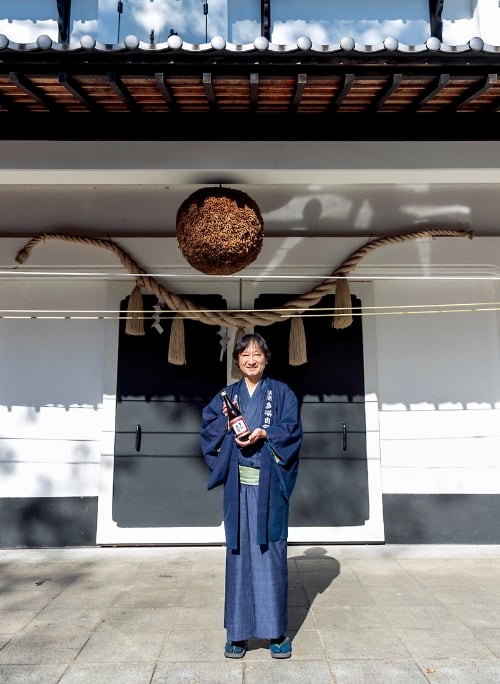 Yahachiro Ishikawa, the 18th-generation CEO, is in the main brewery.
Yahachiro Ishikawa, the 18th-generation CEO, is in the main brewery.
-
- Address
- 1 Kumagawa, Fussa-shi, Tokyo
- Telephone no.
- 042-530-5792 (Direct sales store)
- Business hours
- 10:00-18:00
- Regular closures
- Varies by facility
*There are tours for different periods, including an easy walking course, comparison of drinks, and a main brewery tour. Online reservations are required.
Hotel New Otani
Executive HINOKI Suite
Relax in a cypress bath in a top-tier hotel in the city center
Executive House Zen promises premium hospitality that includes food offered six times a day (providing breakfast, lunch, etc.) and a full-time concierge in residence. Hotel New Otani has created a suite with a cypress bath in this hotel-in-hotel that has received the highest five-star rating. The guest room measuring an expansive 72 square meters has a Japanesque feel throughout the interior decor that includes paper screens. The glassed-in bathroom features a cypress bathtub with a wooden bucket for washing so that Japanese bath culture can be shared with the world. Guests can fully appreciate an incredible view while soaking in the tub that includes the greenery of Akasaka Imperial Residence and State Guest House, Mt. Fuji on a fine day, and a night view of Shinjuku skyscrapers.
-
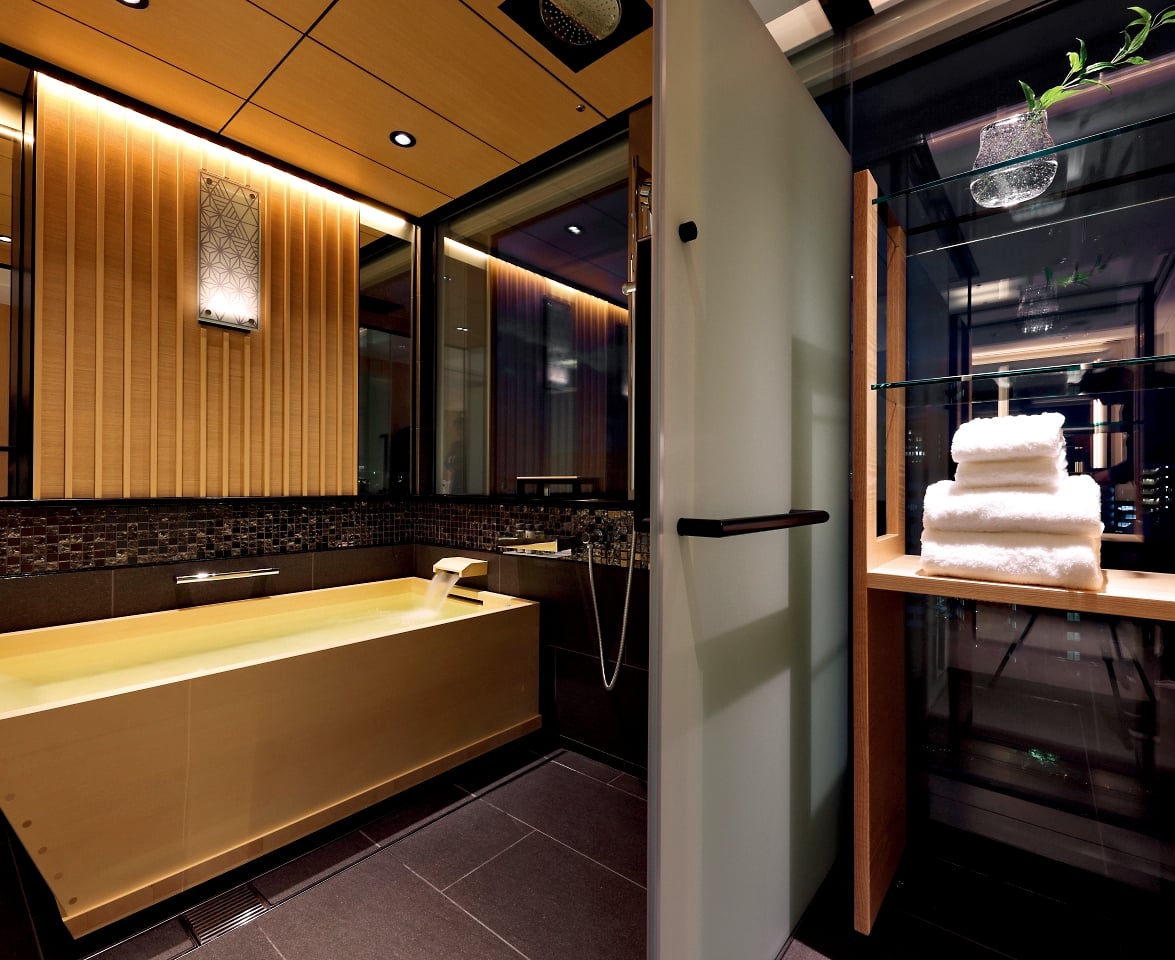 There is only one Executive HINOKI Suite created in Executive House Zen, which has a total of 84 rooms on the 11th and 12th floors of The Main (main building). It accommodates up to three guests. The bath is walled in with glass. Bath amenities include Salvatore Ferragamo Tuscan Soul and soap fashioned after the image of Japanese ink.
There is only one Executive HINOKI Suite created in Executive House Zen, which has a total of 84 rooms on the 11th and 12th floors of The Main (main building). It accommodates up to three guests. The bath is walled in with glass. Bath amenities include Salvatore Ferragamo Tuscan Soul and soap fashioned after the image of Japanese ink. -
-
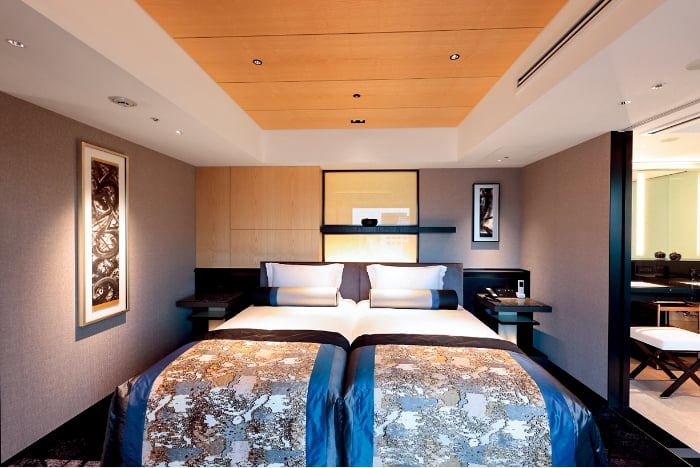 The bedroom can be arranged for either twin beds or a double bed. The sheets are from the long-standing Italian company, Frette.
The bedroom can be arranged for either twin beds or a double bed. The sheets are from the long-standing Italian company, Frette. -
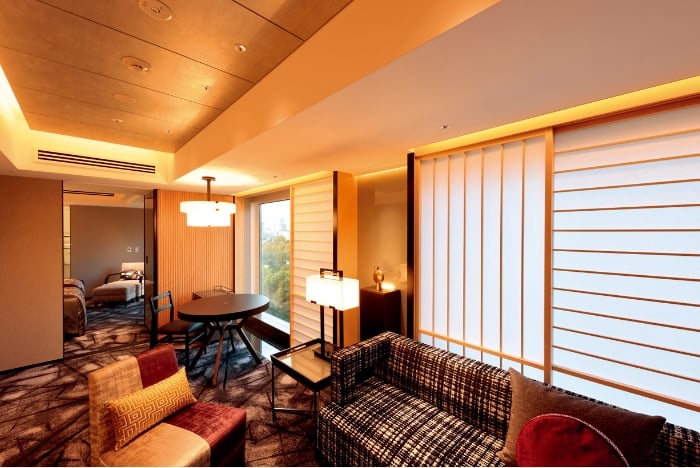 The living area incorporates hues from the Edo period in the ink art and fabrics.
The living area incorporates hues from the Edo period in the ink art and fabrics.
-
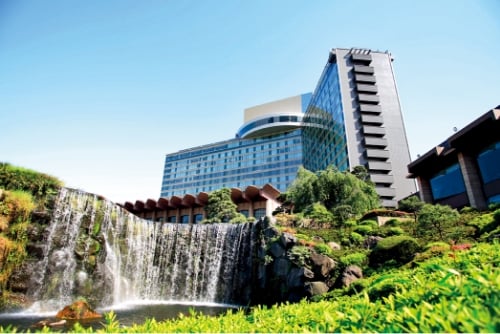
- Address
- 4-1 Kioi-cho, Chiyoda-ku, Tokyo
- Telephone no.
- 03-3234-5678 (Guest room reservations)
- Fee
- Executive HINOKI Suite in Executive House Zen rate per double occupancy room starts at 281,230 yen (as of January 2024); check-in at 15:00, checkout at 12:00; 1 guest room in total
Experience the excitement of traveling to understand culture in Yamagata and Tokyo

Mieko Yoshimura
(Governor of Yamagata Prefecture)
A special experience sharing both Japan’s unspoiled landscapes and latest advances
Yamagata is surrounded by beautiful mountains included among the 100 beautiful mountains of Japan. It is a land of colorful nature in all four seasons where the Mogami River, the “mother river” flows, and spiritual culture still lives on, symbolized by mountain worship that respects and venerates the mountains. In this climate, the sincere and simple character that has been continuously passed down has created unique showpieces, while the clear water and crisp air have given birth to world-class delicious foods and excellent sake, including rice brands such as Tsuyahime, diverse fruits, and a variety of sake and wine produced in the prefecture. Yamagata is also a prefecture of ramen and soba noodles. In addition, there are onsen in every municipality, enabling you to fully relax and unwind in warm comfort. Tokyo melds history and traditions that have continued since the Edo period with the latest culture that constantly inspires innovation. It never ceases to attract people from around the globe. Tokyo. It is one of the world’s largest cities overflowing with diverse attractions, energy, and a sophisticated feeling. Yamagata. It is blessed with many pristine Japanese landscapes that still exist today and richly colorful scenery that changes in each of the four seasons. Together we bring you extraordinary experiences and excitement that share both the latest advancements and unspoiled landscapes of Japan. Enjoy your COOL travels.
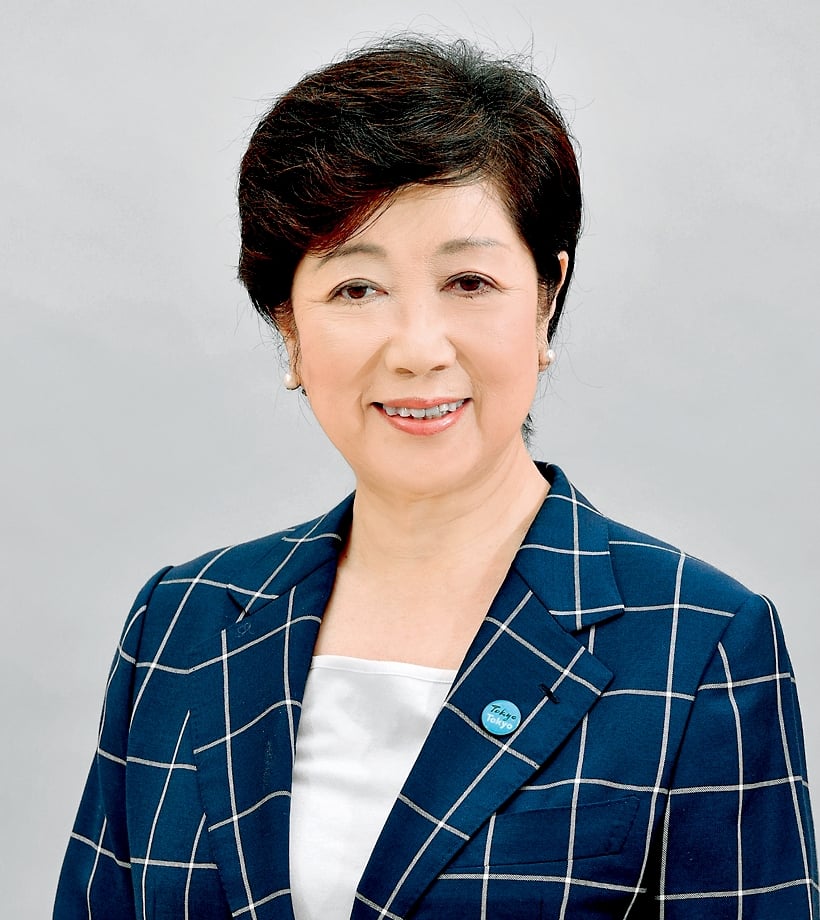
Yuriko Koike
(Governor of Tokyo)
Savor local charms and traditions passed down through time
Tokyo is a vibrant city brimming with diverse attractions and excitement, where traditions dating back to the Edo period coexist with cutting-edge modern culture. New discoveries and learning opportunities await in the form of timeless handicrafts and products rooted in traditions that have been shaped by Tokyo’s natural environment and history and passed down through the ages. Delicious cuisine from around the world will delight your inner gastronome, while safe and pleasant accommodations will make your travels all the more memorable. With new places opening up constantly, there is never a dull moment to be found. Yamagata Prefecture is an area rich in nature that is famous for its wonderful agricultural products such as cherries and rice. With no shortage of tourism resources bursting with stunning natural beauty, including hot springs and picturesque landscapes accentuated by the charms of the seasons, Yamagata is a soul-soothing destination located a convenient bullet train or plane ride away from Tokyo. In both Tokyo and Yamagata, the attractions that exist today are rooted in the traditions, culture, and industries that have been passed down across generations of residents. We encourage you to come visit and savor everything each area has to offer.

